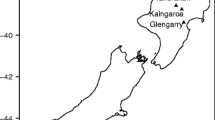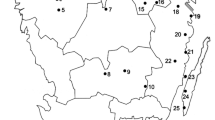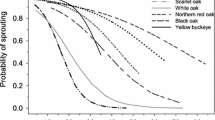Abstract
Regeneration of commercial species is central to long-term success of multiaged management for wood production. We examined relationships between understory light, varying overstory tree retention, and growth of coast redwood (Sequoia sempervirens; commercial species) and tanoak (Notholithocarpus densiflorus) stump sprouts initiated by group selection and single-tree selection harvesting in 80–100 year old mixed stands at four sites. Treatments included a complete harvest in 1-ha group selection openings, low-density dispersed retention, and either aggregated or dispersed high-density retention. Post-harvest stand density index and basal area were useful predictors of understory light. Mean and maximum understory light did not differ significantly between treatments with the same density where residual trees were retained in aggregated versus dispersed spatial patterns. However, the dispersed retention had lower minimum light levels when compared to the aggregated retention treatment. Aspect appeared to influence understory light more in dispersed treatments. At all light levels, the dominant sprout within clumps of redwood stump sprouts generally grew faster than dominant tanoak sprouts within tanoak sprout clumps. Differences in sprout height growth between aggregated and dispersed treatments were minimal. Stump size had a significant effect on redwood stump sprout height growth, with sprouts on the largest stumps growing approximately twice as quickly as sprouts on the smallest stumps. In the low density dispersed treatment, redwood sprouts outperformed tanoak sprouts by the greatest margin. Regeneration of redwood and tanoak was most rapid within group selection openings.





Similar content being viewed by others
References
Adamec Z, Kadavý J, Fedorová B, Knott R, Kneifl M, Drápela K (2017) Development of sessile oak and European hornbeam sprouts after thinning. Forests 8:308
Ahrens GR, Newton M (2008) Root dynamics in sprouting tanoak forests of southwestern Oregon. Can J For Res 38:1855–1866
Baker FS (1949) A revised tolerance table. J For 47(3):179–181
Baldocchi D, Collineau S (1994) The physical nature of solar radiation in heterogeneous canopies: spatial and temporal attributes. In: Caldwell MM, Pearcy RW (eds) Exploitation of environmental heterogeneity by plants, Academic Press. pp 21–71, 429
Barrett MM (1988) A model of third growth coastal redwood sprout establishment and growth under various levels of overstory removal. MS thesis, Humboldt State University
Battaglia MA, Mou P, Palik B, Mitchell RJ (2002) The effect of spatially variable overstory on the understory light environment of an open-canopied longleaf pine forest. Can J For Res 32(11):1984–1991
Bawcom RH, Hubbel RJ, Burns DM (1961) Seasonal diameter growth in trees on Jackson State Forest. Calif Div For State For Note 6:1–5
Berrill J-P, O’Hara KL (2007) Patterns of leaf area and growing space efficiency in young even-aged and multiaged coast redwood stands. Can J For Res 37(3):617–626
Berrill J-P, O’Hara KL (2009) Simulating multiaged coast redwood stand development: interactions between regeneration, structure, and productivity. West J Appl For 24(1):24–32
Berrill J-P, O’Hara KL (2014) Estimating site productivity in irregular stand structures by indexing the basal area or volume increment of the dominant species. Can J For Res 44(1):92–100
Berrill J-P, O’Hara KL (2016) How do biophysical factors contribute to height and basal area development in a mixed multiaged coast redwood stand? J For 89:170–181
Berrill J-P, O’Hara KL, Headley S (2017) Predicting redwood productivity using biophysical data, spatial statistics and site quality indices. In: Standiford RB, Valachovic Y (tech cords) (eds) Proceedings of coast redwood science symposium—2016: past successes and future direction. USDA Forest Service Gen. Tech. Rep. PSW-GTR-258, Albany, CA, pp 39–46, 446
Boe KN (1975). Natural seedlings and sprouts after regeneration cuttings in old-growth redwood. USDA Forest Service Research Paper, Pacific Southwest Forest and Range Experiment Station PSW-111, p 17
Bond WJ, Midgley JJ (2001) Ecology of sprouting in woody plants: the persistence niche. Trends Ecol Evol 16(1):45–51
Brown MJ, Parker GG (1994) Canopy light transmittance in a chronosequence of mixed-species deciduous forests. Can J For Res 24(8):1694–1703
Clark DB, Clark DA, Rich PM, Weiss S, Oberbauer SF (1996) Landscape-scale evaluation of understory light and canopy structures: methods and application in a neotropical lowland rain forest. Can J For Res 26(5):747–757
Devine WD, Harrington TB (2008) Belowground competition influences growth of natural regeneration in thinned Douglas-fir stands. Can J For Res 38(12):3085–3097
Drever CR, Lertzman KP (2001) Light-growth responses of coastal Douglas-fir and western redcedar saplings under different regimes of soil moisture and nutrients. Can J For Res 31(12):2124–2133
Faraway J (2016) Extending the linear model with R: generalized linear, mixed effects and nonparametric regression models, vol 124. CRC Press, Boca Raton, p 331
Forrester JA, Lorimer CG, Dyer JH, Gower ST, Mladenoff DJ (2014) Response of tree regeneration to experimental gap creation and deer herbivory in north temperate forests. For Ecol Manage 329:137–147
Gratzer G, Darabant A, Chhetri PB, Rai PB, Eckmüllner O (2004) Interspecific variation in the response of growth, crown morphology, and survivorship to light of six tree species in the conifer belt of the Bhutan Himalayas. Can J For Res 34(5):1093–1107
Harrington TB, Tappeiner JC, Walstad JD (1984) Predicting leaf area and biomass of 1- to 6-year-old tanoak (Lithocarpus densiflorus) and Pacific madrone (Arbutus menziesii) sprout clumps in southwestern Oregon. Can J For Res 14:209–213
Harrington TB, Tappeiner JC, Warbington R (1992) Predicting crown sizes and diameter distributions of tanoak, Pacific madrone, and giant chinkapin sprout clumps. West J Appl For 7(4):103–108
Harrington TB, Dagley CM, Edwards MB (2003) Above- and belowground competition from longleaf pine plantations limits performance of reintroduced herbaceous species. For Sci 49(5):681–695
Isaaks EH, Srivastava RM (1989) Applied geostatistics. Oxford University Press Inc., New York, p 561
Keyser TL, Zarnoch SJ (2014) Stump sprout dynamics in response to reductions in stand density for nine upland hardwood species in the southern Appalachian Mountains. For Ecol Manage 319:29–35
Lieffers VJ, Messier C, Stadt KJ, Gendron F, Comeau PG (1999) Predicting and managing light in the understory of boreal forests. Can J For Res 29(6):796–811
Lindquist JL (1979) Sprout regeneration of young-growth redwood: sampling methods compared, vol 337. US Dept. of Agriculture, Forest Service, Pacific Southwest Forest and Range Experiment Station, Albany
Lindquist JL, Palley MN (1967) Prediction of stand growth of young redwood. Bull Calif Agric Exp Stn 831: 64
McGuire JP, Mitchell RJ, Moser EB, Pecot SD, Gjerstad DH, Hedman CW (2001) Gaps in a gappy forest: plant resources, longleaf pine regeneration, and understory response to tree removal in longleaf pine savannas. Can J For Res 31(5):765–778
Nicotra AB, Chazdon RL, Iriarte SV (1999) Spatial heterogeneity of light and woody seedling regeneration in tropical wet forests. Ecology 80(6):1908–1926
O’Hara KL (2014) Multiaged silviculture: managing for complex forest stand structures. Oxford University Press, New York, p 213
O’Hara KL, Berrill J-P (2010) Dynamics of coast redwood sprout clump development in variable light environments. J For Res 15(2):131–139
O’Hara KL, Stancioiu PT, Spencer MA (2007) Understory stump sprout development under variable canopy density and leaf area in coast redwood. For Ecol Manage 244(1):76–85
O’Hara KL, Cox LE, Nikolaeva S, Bauer JJ, Hedges R (2017) Regeneration dynamics of coast redwood, a sprouting conifer species: a review with implications for management and restoration. Forests 8:144
Oliver CD, Larson BC (1996) Forest stand dynamics. Wiley, New York, p 520
Olson DF, Roy DF Jr, Walters GA (1990) Sequoia sempervirens (D. Don) Endl. Redwood. In: Silvics of North America, vol 1. USDA Forest Service, pp 541–551
Palik BJ, Mitchell RJ, Houseal G, Pederson N (1997) Effects of canopy structure on resource availability and seedling responses in a longleaf pine ecosystem. Can J For Res 27(9):1458–1464
Palik BJ, Mitchell RJ, Hiers JK (2002) Modeling silviculture after natural disturbance to sustain biodiversity in the longleaf pine (Pinus palustris) ecosystem: balancing complexity and implementation. For Ecol Manag 155(1):347–356
Reineke LH (1933) Perfecting a stand density index for even-aged forests. J Agric Res 46:627–638
Rong L, Wenhui Z, Jingfeng H, Jianyun Z (2013) Survival and development of Liaodong oak stump sprouts in the Huanglong Mountains of China six years after three partial harvests. New Forest 44:1–12
Rydberg D (2000) Initial sprouting, growth and mortality of European aspen and birch after selective coppicing in central Sweden. For Ecol Manag 130:27–35
Stancioiu PT, O’Hara KL (2006) Regeneration growth in different light environments of mixed species, multiaged, mountainous forests of Romania. Eur J For Res 125(2):151–162
Tappeiner JC, McDonald PM, Roy DF (1990) Lithocarpus densiflorus (Hook. & Arn.) Rehd. Tanoak. In: Burns RM, Honkala BH (tech cords) (eds). In: Silvics of North America, vol 2. USDA Forest Service, pp 417–425
Tappeiner JC, Newton M, McDonald PM, Harrington TB (1992) Ecology of hardwoods, shrubs, and herbaceous vegetation: effects on conifer regeneration. Reforestation practices in southwestern Oregon and northern California. Forest Research Laboratory, Oregon State University, Corvallis, Oregon, pp 136–164
Tappeiner JC, Maguire DA, Harrington TB (2007) Silviculture and ecology of western US forests. Oregon State University Press, Corvalis, p 416
Wiant HV Jr, Powers RF (1967) Sprouting of old-growth redwood. In: Proceedings of the 1966 Society of American Foresters, 1966. Society of American Foresters, Washington, pp 88–90, 232
Acknowledgements
We thank Brian Barrett and Shawn Headley of the California Department of Forestry and Fire Protection (CAL FIRE), and Humboldt State University students Devin Eastman, Gabriel Goff, Ethan Hammett, Christopher Kirk, Forrest Kirk, Daniel Kluegel, Travis Munoz, Treelight Morgan-Menzies, Robert Muma, Brandon Namm, Karl Peterson, Aidan Stephens, Chris Valness, FOR 315 classes of spring 2013 and 2014, and FOR 432 classes of fall 2010 and 2011 for field assistance. Funding for this project was provided by the McIntire-Stennis Cooperative Research Program, the University of California (UC-CSU Collaborative Grant) and by CAL FIRE.
Author information
Authors and Affiliations
Corresponding author
Electronic supplementary material
Below is the link to the electronic supplementary material.
Rights and permissions
About this article
Cite this article
Berrill, JP., Schneider, K., Dagley, C.M. et al. Understory light predicts stump sprout growth in mixed multiaged stands in north coastal California. New Forests 49, 815–828 (2018). https://doi.org/10.1007/s11056-018-9636-6
Received:
Accepted:
Published:
Issue Date:
DOI: https://doi.org/10.1007/s11056-018-9636-6




